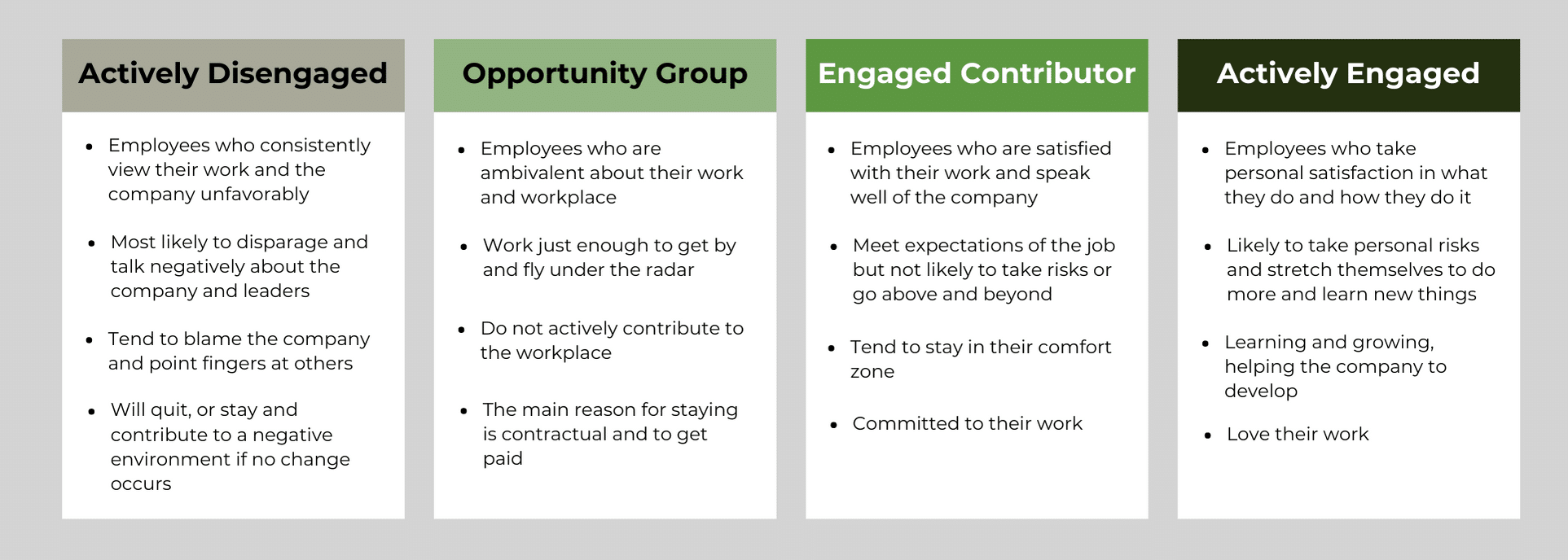At first glance, employee engagement seems simple. But when you dig a bit deeper, and really start to try to measure it, you realize that it is much more nuanced than you’d think. For every organization, there is a whole spectrum and different levels of employee engagement. These engagement levels can ebb and flow and vary from day to day.
What really is employee engagement anyways? There are thousands of different definitions out there. We believe that engagement is the emotional connection an employee feels towards the organization and its goals.
Levels of Engagement
When looking at engagement levels among employees, you’ll find that the majority fall into four main engagement groups: Actively engaged, opportunity group, engaged contributor, and actively engaged. These four groups encompass the spectrum of (dis)engagement.

Actively Disengaged
At one end of the spectrum, we have the actively disengaged group. Within this category, we see the following characteristics:
- Consistently view their work and their company unfavorably
- Most likely to disparage and talk negatively about the company and its leaders
- Tend to blame the company and point fingers at others
- Will quit, or stay and contribute to a negative environment if no change occurs
People who fall into this category are the most at-risk for turnover and can contribute to a negative work environment for others. It is important to try to quickly understand what is affecting these employees and work to get them to reengage with the organization before it is too late. Having a growing number of people in this group can be worrisome because they contribute negatively to the entire workplace and can start affecting the engagement of others around them.
Opportunity Group
Next, we have the opportunity group. Key characteristics of this category include:
- Employees who are ambivalent or indifferent about their work and workplace
- Work just enough to get by and fly under the radar
- Do not actively contribute to the workplace
- The main reason for staying is contractual and to get paid
You can think of this group as the people who are on the fence. They aren’t quite engaged but they aren’t fully checked out either. We refer to them as the opportunity group because there is still a good chance you can work on getting them engaged and can move them in the right direction. You want to avoid ignoring this group at the risk that they will move into the actively disengaged group and consider quitting.
Engaged Contributor
Next, we have the engaged contributor group. This is where we cross over from being indifferent to actually being engaged. Some key features include:
- Satisfied with their work and speak well of the company
- Meet expectations of the job but not likely to take risks or go above and beyond
- Tend to stay in their comfort zone
- Committed to their work
Having a large portion of engaged contributors is positive for your organization. These people are committed to their work, doing a good job, and thinking well of the company. They aren’t going above and beyond but they are a good asset and meet expectations. This is the sweet spot to aim for with engagement.
Actively Engaged
Actively engaged people are at the far end of the spectrum and are the opposite of the actively disengaged group. Key features of these employees include:
- Take personal satisfaction in what they do and how they do it
- Are likely to take personal risks and stretch themselves to do more and learn new things
- Are learning and growing in order to help the company develop
- Love their work
The people who fall into this group are model employees. They are going above and beyond, and exceeding expectations. They are highly engaged in their work and enjoy their workplace. Moving people into this group should be the goal of any organization. Increasing the percentage of your workforce in this group will have positive effects on business outcomes like productivity, sales, and wellbeing.
Boost Workplace Satisfaction with Employee Engagement Surveys
Getting a clear measurement of your team’s level of employee engagement is important. Employee engagement surveys are a useful tool that can help you figure out what percentage of your workforce falls into each category. Once you have a baseline engagement level from collecting employee feedback, you can begin to focus on making improvements that will benefit your whole organization. An engaged workplace is a happy and healthy workplace.




